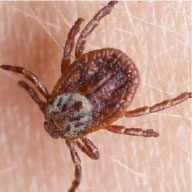American Dog Ticks
Brown with red dotted bodies; large with elaborate dorsal shields; females are 1/4 of an inch in length and up to 1/2 of an inch when engorged

Diet: American dog ticks feed on small animals, like mice and rats when in the early life stage while adults feed on larger animals and humans.
Habitat: American dog ticks do not survive well indoors and prefer grassy areas with low vegetation or environments with brush and open pathways in forests. They can also be found where tree cover is limited. Their preferred environment consists of brightly lit areas with relatively low humidity.
Threats: The vector of Rocky Mountain spotted fever, American dog ticks are also known to transmit tularemia, a rare bacterial infection that can cause tick paralysis.
Control: American dog ticks climb vegetation and outstretch their legs, waiting for an animal or human to pass by to attach. When in areas that are common for ticks, wear light-colored clothing and boots. Avoid grassy areas or walking through brush. Perform tick examinations on people and animals when coming indoors. If you suspect a tick problem on your property, contact a professional pest control company.
